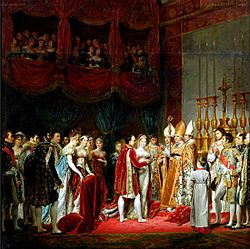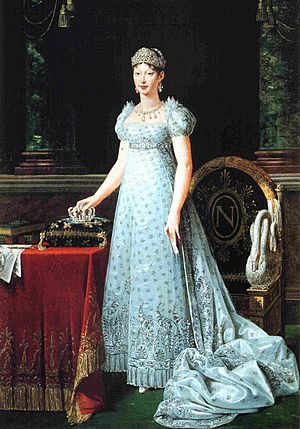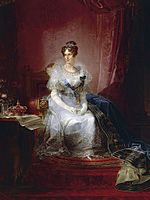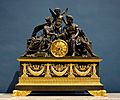Marie Louise, Duchess of Parma facts for kids
Marie Louise (born 12 December 1791 – died 17 December 1847) was an Austrian archduchess who became the Duchess of Parma from 1814 until her death. She was also the second wife of Napoleon Bonaparte. This made her the Empress of the French and Queen of Italy from their marriage in 1810 until Napoleon gave up his power in 1814.
Quick facts for kids Marie Louise |
|||||
|---|---|---|---|---|---|
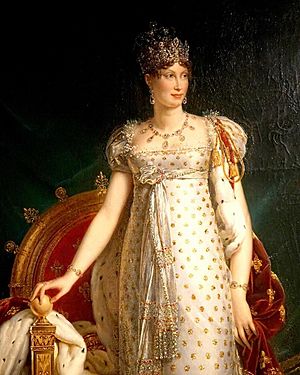
Portrait by Jean-Baptiste Paulin Guérin, c. 1812. She wears a diamond and emerald crown, a necklace, and earrings given as a wedding gift by Napoleon.
|
|||||
| Duchess of Parma, Piacenza and Guastalla | |||||
| Reign | 11 April 1814 – 17 December 1847 | ||||
| Predecessors |
|
||||
| Successors |
|
||||
| Empress consort of the French Queen consort of Italy |
|||||
| Tenure | 1 April 1810 – 6 April 1814 | ||||
| Born | 12 December 1791 Hofburg, Vienna, Austria, Holy Roman Empire |
||||
| Died | 17 December 1847 (aged 56) Parma, Duchy of Parma |
||||
| Burial | Imperial Crypt | ||||
| Spouse |
Charles-René, Count of Bombelles
(m. 1834) |
||||
| Issue |
|
||||
|
|||||
| House | Habsburg-Lorraine | ||||
| Father | Francis II, Holy Roman Emperor | ||||
| Mother | Maria Theresa of Naples and Sicily | ||||
| Religion | Roman Catholicism | ||||
| Signature | |||||
Marie Louise was the oldest child of Francis II, Holy Roman Emperor, and his second wife, Maria Theresa of Naples and Sicily. She grew up during a time when Austria and France were often at war. Napoleon Bonaparte's victories had greatly affected Austria. This led to the end of the Holy Roman Empire.
After a war in 1809, Napoleon and Marie Louise married in 1810. This brought a short time of peace between Austria and France. Marie Louise agreed to the marriage even though she had been taught to dislike France. Napoleon adored her. He wanted to marry into a major royal family to make his new empire stronger. They had a son, who was called the King of Rome. He later became Napoleon II.
Napoleon's luck changed after his failed invasion of Russia in 1812. Other European countries, including Austria, fought against France again. This war ended with Napoleon giving up his power and being sent away to Elba. The Treaty of Fontainebleau in 1814 gave the regions of Parma, Piacenza, and Guastalla to Marie Louise. She ruled these areas until her death.
After Napoleon died in 1821, Marie Louise married two more times. Her second husband was Count Adam Albert von Neipperg. They married in 1821 and had three children. After Neipperg died in 1829, she married Count Charles-René de Bombelles in 1834. Marie Louise died in Parma in 1847.
Contents
Early Life and Education
Archduchess Marie Louise of Austria was born at the Hofburg Palace in Vienna on 12 December 1791. Her parents were Archduke Francis of Austria and his second wife, Maria Theresa of Naples and Sicily. She was named after her grandmother, Marie Louise, Holy Roman Empress. Her father became the Holy Roman Emperor a year later.
Marie Louise grew up during a time of conflict between France and her family. She was taught to dislike France and French ideas. Her grandmother, Maria Carolina, greatly influenced her. Maria Carolina hated the French Revolution because it led to the death of her sister, Marie Antoinette. The War of the Third Coalition almost ruined Austria, which made Marie Louise dislike Napoleon even more.
In 1805, her family had to leave Vienna. Marie Louise stayed in Hungary and later Galicia before returning to Vienna in 1806. Her father gave up his title of Holy Roman Emperor but remained the Emperor of Austria.
To prepare her for marriage, her parents had her learn many languages. Besides her native German, she learned English, French, Italian, Latin, and Spanish.
In 1807, when Marie Louise was 15, her mother died. Less than a year later, her father married his cousin, Maria Ludovika of Austria-Este. Maria Ludovika was only four years older than Marie Louise. She became like a mother to her stepdaughter. She also disliked the French, who had taken her father's Duchy of Modena.
Another war broke out between France and Austria in 1809. Austria lost again. The Imperial family had to flee Vienna once more before the city surrendered on 12 May.
Marriage Proposal
After a difficult time in Vienna in 1809, Emperor Napoleon decided he needed a child to make his new empire stronger. He also wanted to marry into a leading royal family in Europe to gain more respect. He began the process to divorce Joséphine de Beauharnais, who had not had a son with him.
Napoleon first wanted to marry Grand Duchess Anna Pavlovna of Russia. This worried Austria, as they feared being caught between two powerful allies. Prince Metternich suggested a marriage between Napoleon and Marie Louise. Marie Louise was not told about these plans at first.
When the marriage talks with Russia slowed down, Napoleon decided to marry Marie Louise. He signed the marriage contract with the Austrian ambassador on 7 February 1810. Marie Louise was told about the marriage by Metternich. When asked if she agreed, she said: "I wish only what my duty commands me to wish."
Wedding Ceremonies
Marie Louise was married to Napoleon by proxy on 11 March 1810 in Vienna. This meant someone stood in for Napoleon. Her uncle, Archduke Charles, represented Napoleon. The wedding was very grand. She officially became the Empress of the French and Queen of Italy.
Marie Louise left Vienna on 13 March. When she arrived in France, she went through a special tradition. She had to remove all her Austrian clothes and wear French bridal clothes. She met Napoleon for the first time on 27 March. She told him: "You are much better-looking than your portrait."
The civil wedding took place on 1 April 1810. The next day, Napoleon and Marie Louise traveled to Paris in a special coach. The Imperial Guard rode in front, followed by other carriages. They arrived at the Tuileries Palace and went to the chapel for the religious wedding. The ceremony was led by Cardinal Joseph Fesch, Napoleon's uncle.
Many celebrations continued in May and June 1810. These included a ball, a masked party, a pretend sea-battle on the Seine River, and fireworks for 4,000 people.
Life as Empress
Marie Louise was a loyal wife and quickly adjusted to life at the French court. She became good friends with her main lady-in-waiting, the Duchess of Montebello. Napoleon worked hard to make her happy. He even said he preferred Marie Louise to his first wife, Joséphine. Marie Louise wrote to her father: "I assure you, dear papa, that people have done great injustice to the Emperor. The better one knows him, the better one appreciates and loves him."
Their marriage brought a time of peace between France and Austria. The people of Vienna, who had disliked Napoleon, now praised him. Napoleon and Marie Louise exchanged friendly letters with her father and stepmother.
In public, Marie Louise was quiet because she was shy. Some people thought this meant she was proud. But in private, she was kind and gentle. She did not get involved in politics. Napoleon also arranged for her to help with some charity work.
Birth of a Son

Marie Louise became pregnant in July 1810. She gave birth to a son on 20 March 1811. The boy, Napoléon François Joseph Charles Bonaparte, was given the title King of Rome. This was a tradition for the heir to the Holy Roman Empire. Napoleon was very happy that his wife survived the birth.
Marie Louise loved her son very much. She had him brought to her every morning and visited him often during the day.
Return to War
In May 1812, Marie Louise went with Napoleon to Dresden. There, she met her father and stepmother. Her father told Napoleon that Austria would support him in the upcoming war. This was just before the French invasion of Russia. Marie Louise also met Count Adam Albert von Neipperg for the first time in Dresden. Napoleon left Dresden on 29 May to lead his army.
Marie Louise then went to Prague for a few weeks before returning to France. She stayed in touch with Napoleon during the war. The invasion of Russia ended badly for France. Many soldiers were lost due to the cold winter and attacks. Napoleon quickly returned to France in December.
Empire's Fall
France's weakened position led to the War of the Sixth Coalition. Prussia and the United Kingdom joined Russia in fighting France. Austria stayed out at first because of the family ties. On 30 March, Marie Louise was made Regent, meaning she would rule while Napoleon was away fighting. However, Napoleon still made all the important decisions. Marie Louise tried to get her father to side with France, but Austria joined the other countries against France.
Napoleon was defeated in Leipzig on 19 October and returned to France. On 23 January 1814, Marie Louise was made Regent again. On 25 January, Napoleon said goodbye to Marie Louise and their son for the last time. He left to lead his army against the Allied invasion.
As the Allies got closer to Paris, Marie Louise did not want to leave. She thought that as the daughter of the Austrian ruler, she would be treated well. She also hoped her son might still become king if Napoleon was removed from power. She was finally convinced to leave Paris on 29 March. The Allies entered the city the next day.
Marie Louise and her court moved to Blois. She did not expect her father to remove Napoleon from power or take away her son's right to the French throne. On 3 April, the Senate announced that Napoleon was no longer Emperor. Marie Louise found out on 7 April and was very surprised. She wanted to go back to Paris, but her doctor and the Duchess of Montebello stopped her.
Napoleon's Exile
Napoleon gave up his throne on 11 April 1814. The Treaty of Fontainebleau sent him to Elba. It also allowed Marie Louise to keep her royal title and made her the ruler of Parma, Piacenza, and Guastalla, with her son as her heir. This plan was later changed.
Her advisors strongly told Marie Louise not to join Napoleon on Elba. They told her that Napoleon was very sad about Joséphine's death. On 16 April, her father came to meet her. Marie Louise left for Vienna with her son on 23 April. In Vienna, she stayed at Schönbrunn. She saw her sisters often, but rarely her father or stepmother. Her grandmother, Maria Carolina, was upset that Marie Louise had left her husband. Marie Louise felt very unhappy and wrote on 9 August 1814: "I am in a very unhappy and critical position; I must be very careful in my behavior."
Duchess of Parma and Later Marriages
In the summer of 1814, Marie Louise's father sent Count Adam Albert von Neipperg to go with her to a spa town. This was to stop her from joining Napoleon on Elba. Neipperg was a trusted friend of Metternich and an enemy of Napoleon. Marie Louise fell in love with Neipperg. He became her chamberlain and supported her at the Congress of Vienna. People in France and Austria were not happy about their relationship.
When Napoleon escaped in March 1815 and returned to power, the Allies declared war again. Marie Louise was asked to pray for the Austrian armies, but she refused. She sent a message to Napoleon's secretary saying she hoped he would understand her difficult situation. She said she would never agree to a divorce but wanted a friendly separation. Napoleon was defeated for the last time at the Battle of Waterloo and was sent to Saint Helena in October 1815. He did not try to contact her again.
The Congress of Vienna recognized Marie Louise as the ruler of Parma, Piacenza, and Guastalla. However, they did not allow her to bring her son to Italy. They also made her Duchess of Parma only for her lifetime. This was because the Allies did not want a descendant of Napoleon to have a permanent claim to Parma. After her death, the duchy would go back to the Bourbons.

Marie Louise left for Parma on 7 March 1816 with Neipperg. She arrived on 18 April. She wrote to her father that people welcomed her with great excitement. She mostly let Neipperg manage the daily affairs of the duchy. In December 1816, Marie Louise made Neipperg her prime minister.
She and Neipperg had four children:
- Albertine, Countess of Montenuovo (1817–1867)
- William Albert, Count of Montenuovo (1819–1895)
Napoleon died on 5 May 1821. On 8 August, Marie Louise married Neipperg in a private ceremony. Neipperg died on 22 February 1829, which greatly saddened Marie Louise. Austria did not allow her to mourn him publicly.
Marie Louise's son by Napoleon, known as "Franz," was given the title Duke of Reichstadt in 1818. Franz lived at the Austrian court. His grandfather showed him great affection. However, Austrian officials tried to keep him from having any real power. There were worries that he might be taken to France to reclaim the throne. Franz became unhappy with his Austrian relatives and his mother for not supporting him more. He began to see himself as Napoleon II. Sadly, Napoleon II died at age 21 in Vienna in 1832 from tuberculosis.
In 1831, there were uprisings in Italy. In Parma, people protested against her prime minister. Marie Louise did not know what to do and wanted to leave the city. Protesters stopped her, hoping she would listen to their demands. She managed to leave Parma between 14 and 15 February. The rebels then formed a temporary government. She wrote to her father, asking him to replace her prime minister. Her father sent Austrian troops, who stopped the rebellion. To prevent more trouble, Marie Louise gave forgiveness to the protesters on 29 September.
In 1833, Metternich sent Charles-René de Bombelles to replace her prime minister. Bombelles was a French nobleman who had served in the Austrian army. He was a very good prime minister and improved the duchy's finances. He was a widower and became close friends with Marie Louise. Six months after he arrived, on 17 February 1834, she married him in a private ceremony.
Death
Marie Louise became ill on 9 December 1847. Her health got worse over the next few days. On 17 December, she passed out and did not wake up again. She died that evening. The cause of death was determined to be pleurisy, a lung condition.
Her body was taken back to Vienna and buried in the Imperial Crypt.
Arms
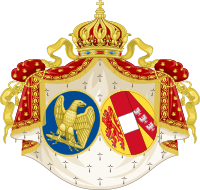 Marie Louise's coat of arms as Empress |
 Marie Louise's special symbol |
 Her coat of arms as Duchess of Parma |
Her coat of arms as Duchess of Parma is used as the logo for the perfume company Acqua di Parma. This honors her role in helping to develop the perfume and glass industry in Parma.
Gallery
-
Marie Louise's tomb in the Imperial Crypt, Vienna
See also
 In Spanish: María Luisa de Austria para niños
In Spanish: María Luisa de Austria para niños


